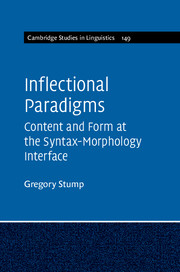Book contents
- Frontmatter
- Dedication
- Contents
- List of figures
- List of tables
- Acknowledgements
- List of abbreviations
- List of symbols and operators
- Introduction
- 1 What are inflectional paradigms?
- 2 Canonical inflectional paradigms
- 3 Morphosyntactic properties
- 4 Lexemes
- 5 Stems
- 6 Inflection classes
- 7 A conception of the relation of content to form in inflectional paradigms
- 8 Morphomic properties
- 9 Too many cells, too few cells
- 10 Syncretism
- 11 Suppletion and heteroclisis
- 12 Deponency and metaconjugation
- 13 Polyfunctionality
- 14 A theoretical synopsis and two further issues
- References
- Index
3 - Morphosyntactic properties
Published online by Cambridge University Press: 18 December 2015
- Frontmatter
- Dedication
- Contents
- List of figures
- List of tables
- Acknowledgements
- List of abbreviations
- List of symbols and operators
- Introduction
- 1 What are inflectional paradigms?
- 2 Canonical inflectional paradigms
- 3 Morphosyntactic properties
- 4 Lexemes
- 5 Stems
- 6 Inflection classes
- 7 A conception of the relation of content to form in inflectional paradigms
- 8 Morphomic properties
- 9 Too many cells, too few cells
- 10 Syncretism
- 11 Suppletion and heteroclisis
- 12 Deponency and metaconjugation
- 13 Polyfunctionality
- 14 A theoretical synopsis and two further issues
- References
- Index
Summary
Each cell in a lexeme's inflectional paradigm is distinguished by its association with a particular set of morphosyntactic properties. As observed in Section 1.3.2, the morphology, syntax and semantics of the word form realizing a particular cell may all depend on that cell's morphosyntactic properties. In syntax, a word form's morphosyntactic properties identify the grammatical characteristics that it possesses, either inherently or as an effect of its syntactic context; these properties determine the particular syntactic relations in which the word form may participate within a sentence. Some such properties (e.g. plural number in most languages) have specific semantic correlates, while others (e.g. masculine gender in many languages) do not. In morphology, a word form's morphosyntactic properties determine the inflectional exponents involved in its realization.
In this chapter, I consider the role of morphosyntactic properties in the structure of inflectional paradigms. I begin by examining the ways in which inflectional categories may vary, with respect to both the complexity of their values and the syntactic categories with which they are associated (Section 3.1). I then discuss the different ways in which morphosyntactic properties may be associated with word forms (Section 3.2); the combinations into which morphosyntactic properties enter (Section 3.3); the kinds of relations that exist between morphosyntactic property sets (Section 3.4); constraints on morphosyntactic property sets and the satisfaction of these constraints (Section 3.5); and the realization of morphosyntactic properties by their exponents (Section 3.6). I conclude by discussing a puzzle concerning the representation of morphosyntactic properties in noncanonical paradigms (Section 3.7).
Different kinds of inflectional categories
An inflectional category has a set of related but mutually exclusive values; in formal terms, a morphosyntactic property is the pairing of an inflectional category with one of its values, e.g. “tense:past.” Inflectional categories vary with respect to the complexity of their values. Atom-valued inflectional categories have simple values, such as “past,” “accusative” or “plural.” But it is sometimes desirable to postulate set-valued inflectional categories whose values are themselves sets of morphosyntactic properties (Gazdar et al. 1985: 25); for instance, an inflectional category AGR might have values such as {person:3, number:pl, gender:fem}.
Information
- Type
- Chapter
- Information
- Inflectional ParadigmsContent and Form at the Syntax-Morphology Interface, pp. 43 - 57Publisher: Cambridge University PressPrint publication year: 2015
